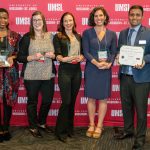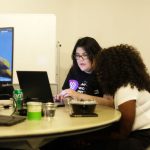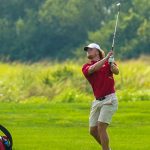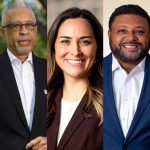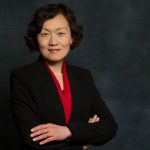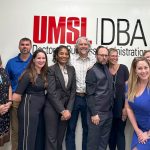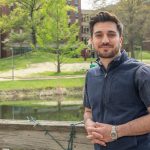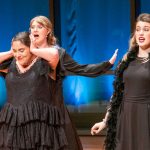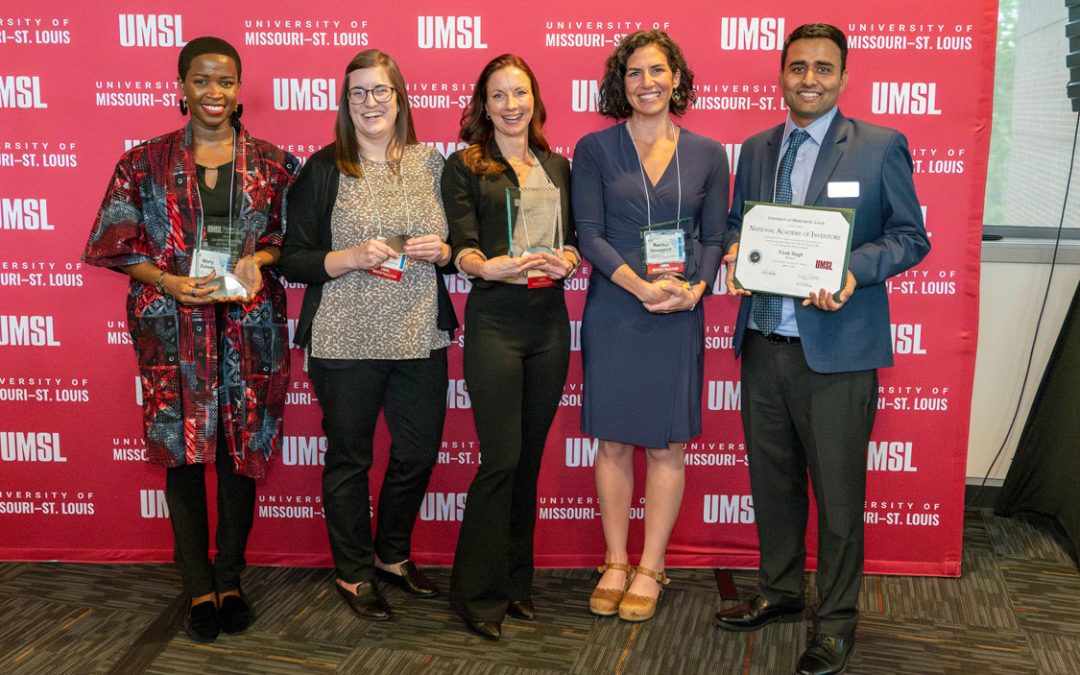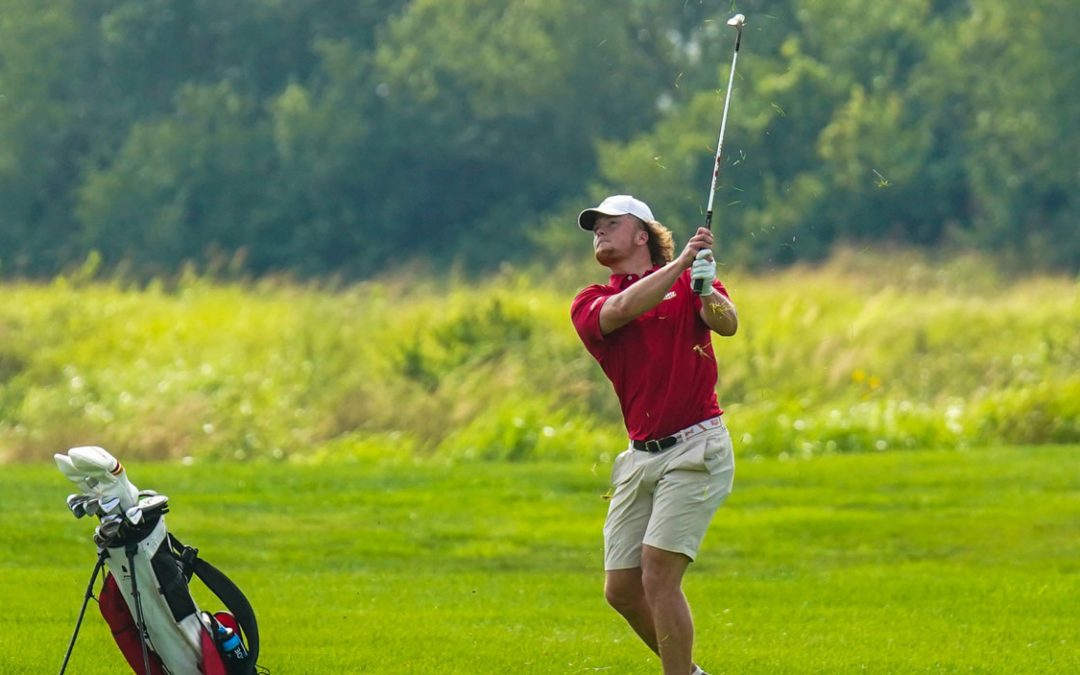
Tianna McBroom, senior physics major and incoming student coordinator for the UMSL Astronomy Outreach Program, directs the Ferguson Middle School students’ attention to an object in the dome at the UMSL Planetarium. The NASA-Missouri Space Grant Consortium helped make the students’ visit to UMSL and the Challenger Learning Center possible. (Photo by August Jennewein)
“Wow…”
A collective, audible surprise came over the visiting class from Ferguson Middle School as the planetarium at the University of Missouri–St. Louis lit up with constellations above their heads.
“Does anyone know what this is?” senior physics major Tianna McBroom asked of the class while pointing to a familiar pattern of stars in the dome’s night sky.
Shy at first, a few of the students whispered, “the Big Dipper.”
McBroom took the opportunity to teach them the difference between a constellation and an asterism, a commonly recognizable pattern of stars but not necessarily a constellation in and of itself, although it may be part of one. She traced out the constellation Ursa Major, or the Great Bear, showing the students how the Big Dipper makes up its back and tail.
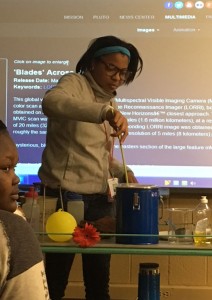
During the classroom presentation at UMSL, Ferguson Middle School students learned about comets, jokingly called “dirty snowballs.” Later, a UMSL student made one out of soil, dry ice, water and ammonia. (Photo provided by Gina Pereda)
Around the room, pointed fingers were in the air as students traced the star patterns for themselves and whispered among each other.
For McBroom, it was one presentation in a series she will give over the next year as the incoming student coordinator for the UMSL Astronomy Outreach Program.
The program, free to local elementary and middle schools, offers students an opportunity to explore space through a planetarium presentation and classroom presentation at UMSL. This year, the UMSL program also partnered with the Challenger Learning Center so that the students had the opportunity to experience the CLC’s Simulated Space Mission as part of a comprehensive field trip.
Funding by the NASA-Missouri Space Grant Consortium helps support UMSL students who serve as the program’s student coordinators. It also pays for the program fees and busing of the elementary and middle school students.
“We have been offering the Astronomy Outreach Program for free to area grade school and middle school students for 20 years, but interest had languished, in part due to transportation costs no longer covered by the schools,” said astronomy Professor Bruce Wilking, who didn’t want local youth to miss out. “Thanks to the NASA-Missouri Space Grant Consortium this is no longer an issue.”
More than 450 elementary and middle school students participated this year alone, and 117 of those were from Ferguson Middle School, which had multiple classes visit UMSL and the CLC this spring.
“The goal of our program and new partnership is to inspire students, especially underserved and underrepresented groups, to be excited about classes and careers in STEM fields,” he said.
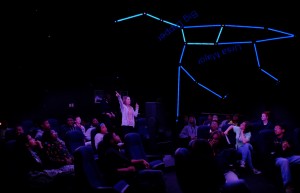
This composite image showing the constellation Ursa Major offers a glimpse of what students may see above them in the planetarium. Click on the image to enlarge it. (Photo by August Jennewein)
Longtime Ferguson Middle School science teacher Gina Pereda sees the same benefit.
“It gets them into the real world,” she said. “And for some, who never ever would think of it as a future career, these kind of experiences ignite new interests that could drive them to do something more with their lives. It shows them options outside of becoming a sports star or a lawyer.”
Graduating student coordinator and physics major Alex Bretana can attest to the program’s success. He’s done 10 shows this year and nearly 30 over the past two years as the Department of Physics and Astronomy kick started the renovated planetarium for the outreach program.
Things really shaped up with the new planetarium projector bought by the College of Arts and Sciences at UMSL. Bretana helped break in the new system that makes audiences feel like they are flying through the sky and traveling across the galaxy in a heartbeat.
“The old system was pretty rudimentary,” Bretana teased of the spinning ball with holes poked in it. “We couldn’t show anything but a star field. On this new system, we produced an automated show, which allowed us to be more involved.”
In fact, the Ferguson Middle School students got “the Mars experience,” a special show developed by Bretana and Mars expert and Assistant Teaching Professor David Horne. It’s devoted to exploring the red planet, its orbit and moons.
“We tailor shows to classes or open houses,” Bretana said. “And the new projector system allows us the flexibility to answer questions by pulling up any star or planet we have available to us in our program.”
The students asked to see the now-dwarf-planet Pluto and Saturn, of course.
“I loved the really specific details of everything I learned,” said Ferguson Middle School student Lawerence Couch, 13. “My favorite part was seeing Saturn’s rings so close like that.”
Classmate and space enthusiast Allison Durham, 14, was extra excited about the field trip.
“I love space!” she said. “Especially the unknown. We constantly have to form these hypotheses and prove them. We got to see all we’ve learned so far, and the unknown we still have left to see. Now we’ll test new hypotheses.”
And while they also asked to see the popular red eye of Jupiter, visiting students aren’t always so predictable. That’s something McBroom, who wants to be a future astrophysics professor, likes as a presenter.
“The questions really surprise you sometimes, which is vindicating, but more importantly promising,” she said. “Kids can think for themselves, so it’s great that we are catching younger generations early.”



